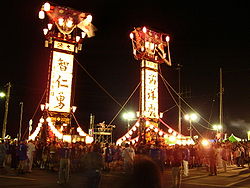Nanao, Ishikawa
|
Nanao 七尾市 |
|
|---|---|
| City | |

Ishizaki Kiriko Lantern Festival in August
|
|
 Location of Nanao in Ishikawa Prefecture |
|
| Location in Japan | |
| Coordinates: 37°2′N 136°58′E / 37.033°N 136.967°ECoordinates: 37°2′N 136°58′E / 37.033°N 136.967°E | |
| Country | Japan |
| Region | Chūbu (Hokuriku) |
| Prefecture | Ishikawa Prefecture |
| Government | |
| • Mayor | Bunpei Takemoto |
| Area | |
| • Total | 318.02 km2 (122.79 sq mi) |
| Population (2010) | |
| • Total | 58,204 |
| • Density | 183/km2 (470/sq mi) |
| Symbols | |
| • Tree | Japanese Evergreen |
| • Flower | Azalea |
| • Bird | Seagull |
| • Fish | Red Snapper |
| Time zone | Japan Standard Time (UTC+9) |
| City hall address | I-25 Sodegaemachi, Nanao-shi, Ishikawa-ken 926-8611 |
| Website | www |
Nanao (七尾市 Nanao-shi?) is a city located in Ishikawa Prefecture, Japan.
As of March 1, 2010, the city has an estimated population of 58,204 and a population density of 183 persons per km². The total area is 318.02 km².
Nanao is the fifth largest city by population in Ishikawa, behind Kanazawa, Hakusan, Komatsu, and Kaga.
Nanao is situated in the middle of the Noto Peninsula and was the ancient capital of Noto Province. It has several popular onsen (hot springs) such as Wakura Onsen, a resort town which is regarded as one of the best onsen in Japan.
On March 25, 2007, the 2007 Noto earthquake shook Nanao and nearby communities.
An Imperial decree in July 1899 established Nanawo as an open port for trading with the United States and the United Kingdom.
The city of Nanao was founded on July 20, 1939. The name "Nanao" (七尾) literally means "Seven Tails" and is said to be named for the seven mountain ridges (or "tails") surrounding Nanao that are visible when viewed from Joyama (七尾城山), site of the city's historical castle ruins. These ridges are called Kikuo (菊尾, "Chrysanthemum Tail"), Kameo (亀尾, "Turtle Tail"), Matsuo (松尾, "Pine Tail"), Torano'o (虎尾, "Tiger Tail"), Takeo (竹尾, "Bamboo Tail"), Umeo (梅尾, "Plum Tail"), and Tatsuo (龍尾, "Dragon Tail").
...
Wikipedia

